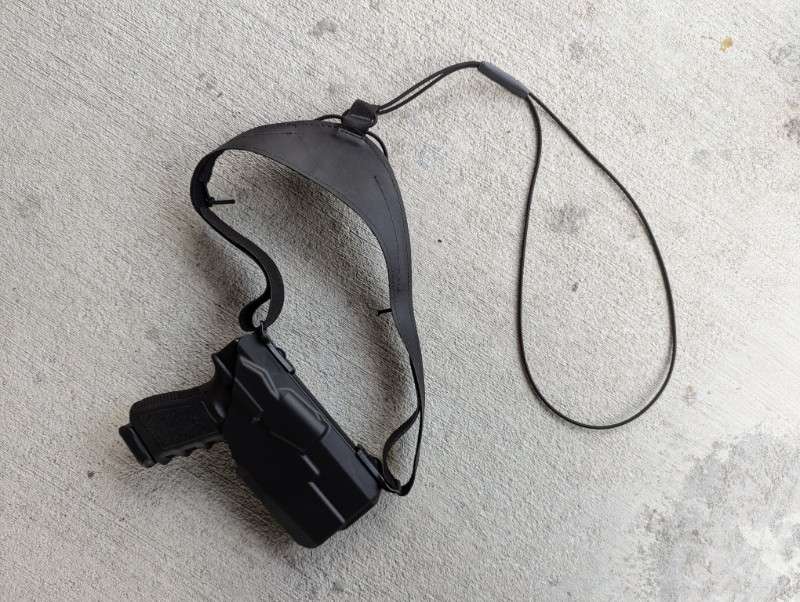The world of concealed carry offers a multitude of options, each with its own set of advantages and disadvantages. Among these, the shoulder holster stands out as a classic and often preferred method, particularly for those who prioritize comfort and accessibility while carrying a larger firearm. Understanding the anatomy of a shoulder holster is crucial for selecting the right model and ensuring safe and effective use. This guide delves into the different components of these systems, exploring their functionality and impact on the overall carry experience. This is why we should learn the advantages of the shoulder holster.
Understanding the Core Components
A shoulder holster system is more than just a pouch for your handgun. It’s a complex network of straps, harnesses, and securing mechanisms designed to distribute weight and keep your firearm readily available. Let’s break down the key elements:
- Harness: The harness is the foundation of the system, typically consisting of straps that loop over the shoulders and around the torso. Its design dictates weight distribution and overall comfort. Materials range from leather and nylon to more advanced synthetic fabrics.
- Holster Pouch: This component houses the firearm itself. It’s crucial that the pouch provides a secure and snug fit, preventing accidental dislodging while allowing for a smooth and quick draw. Retention mechanisms, such as thumb breaks or friction devices, further enhance security.
- Counterbalance: Often overlooked, the counterbalance is a pouch or weight positioned on the opposite side of the holster. Its purpose is to offset the weight of the firearm, preventing the harness from pulling unevenly and causing discomfort or fatigue. This is critical for long-term comfort.
- Tie-Downs: These straps connect the holster and counterbalance to the belt, providing additional stability and preventing unwanted movement during activity. They are often adjustable to accommodate different body types and carry preferences.
Exploring Different Styles and Features
Shoulder holsters aren’t a one-size-fits-all solution. Different styles cater to various needs and preferences. Here are a few common variations:
Horizontal vs. Vertical Holsters
The orientation of the holster pouch significantly impacts concealment and draw speed. Horizontal holsters offer a quicker draw, but can be more challenging to conceal, particularly with longer firearms. Vertical holsters, on the other hand, provide better concealment but may require a more deliberate draw stroke.
Materials and Construction
The materials used in a shoulder holster greatly influence its durability, comfort, and concealability. Leather offers a classic look and feel, while nylon provides superior resistance to moisture and abrasion. Hybrid designs combining leather and nylon offer a balance of aesthetics and functionality.
Adjustability and Customization
A well-designed shoulder holster should offer a wide range of adjustability to accommodate different body types and clothing styles. Adjustable straps, retention devices, and tie-downs allow you to fine-tune the fit and ensure optimal comfort and performance.
The comfort and utility of a shoulder holster can vary widely depending on the design, materials, and how well it’s fitted to the individual. Many prefer the shoulder holster for its all-day comfort and the ability to carry a larger weapon discreetly.
Safety Considerations and Best Practices
Carrying a firearm in a shoulder holster requires diligent attention to safety. Always practice drawing and re-holstering with an unloaded firearm to develop muscle memory and ensure a smooth and safe motion. Regularly inspect your holster for signs of wear and tear, and replace it if necessary. Additionally, be mindful of your surroundings and avoid drawing attention to yourself. Remember, safe gun handling is paramount, regardless of the carry method.
Choosing the Right Shoulder Holster
Selecting the right shoulder holster is a personal decision that depends on your individual needs and preferences. Consider your body type, clothing style, and the size of your firearm. Research different models, read reviews, and try on different options before making a purchase. The first sentence to take into account is that choosing the correct shoulder holster will greatly improve your concealed carry experience.
Maintenance and Longevity
Like any piece of equipment, a shoulder holster requires regular maintenance to ensure its functionality and extend its lifespan. Leather holsters should be cleaned and conditioned periodically to prevent drying and cracking. Nylon holsters can be cleaned with mild soap and water. Inspect all straps, buckles, and retention devices for signs of wear and tear. Replace any damaged components immediately to prevent potential safety hazards. Proper care and maintenance will ensure that your shoulder holster provides years of reliable service.
Legal Considerations
Before carrying a firearm in a shoulder holster, it’s crucial to understand the laws and regulations in your area. Concealed carry laws vary significantly from state to state, and some jurisdictions may have specific restrictions on certain carry methods. Research your local laws and obtain any necessary permits or licenses. Familiarize yourself with the legal requirements for carrying a concealed firearm, including restrictions on where you can carry and when you can use deadly force. Compliance with all applicable laws is essential for responsible gun ownership.
The Future of Shoulder Holster Design
The design and materials used in shoulder holsters are constantly evolving. Advancements in materials science are leading to lighter, more durable, and more comfortable holsters. New designs are incorporating modular components, allowing users to customize their holsters to fit their specific needs. Integrated lighting systems and other accessories are also becoming increasingly common. The future of shoulder holster design promises to offer even greater levels of comfort, concealability, and functionality.
Ultimately, the decision to use a shoulder holster is a personal one. When properly chosen and maintained, they can provide a comfortable and effective method of concealed carry. Prioritize safety, practice regularly, and stay informed about the laws and regulations in your area. The informed and responsible use of any firearm carry system, including the shoulder holster, contributes to a safer community for everyone.

